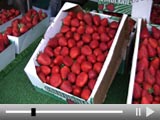Restored salmon habitat on the Stanislaus River Entitled “Replenishing a River: Stanislaus River Honolulu Bar Restoration,” this 11-minute video uses underwater photography, still images and narration to illustrate an important project for restored salmon habitat that was completed in 2012. The Oakdale Irrigation District and U.S. Fish and Wildlife Service split the cost of the […]
California Drought – Food Supply
California is the 4th largest supplier of food to the world and the #1 largest supplier of food to the entire United States. During the 2014 California Drought farmers don’t always have the water they need to grow the food we buy at the grocery store, but there are proposed solutions on the November ballot. […]
California Drought – Invest
People everywhere need water. Farmers use water to grow the food we buy at the grocery store. But we need to invest in our water supply system to make sure we have enough water today and in the future – for drinking, for cooking and cleaning, and for growing healthy and delicious food.
How Farmers Conserve Water
Learn how California farmers use advanced technology, irrigation scheduling and soil moisture monitoring to conserve water while producing a variety of fresh food products we all find at the grocery store.
Continue readingWater Rally 3-18-2014 Firebaugh, Ca
Steve Malanca “The issues have been difficult to explain to those who aren’t familiar with agriculture.” This video explains the connection between farms and the businesses that depend on them.
Continue readingFarm Water and the Business Crisis
Steve Malanca “The issues have been difficult to explain to those who aren’t familiar with agriculture.” This video explains the connection between farms and the businesses that depend on them.
Continue readingFarm Water & Earth Day
No one knows more about Earth Day than the farmers who use water to produce food from the land. Believe it or not, many people think their food comes from the grocery store but it actually comes from productive farms, many of which are in California
Continue readingFarm Water and the Big Fix
California’s water supply is broken. Find out who needs to fix it and what needs to be done to provide water supplies for California’s farms, homes and businesses.
Continue readingA River for All
San Joaquin River restoration projects have been the focus of controversy since the early days of California. This video explores the history of water development in California and how decisions made in the 19th Century and beyond played a role in the water system we have today.
Continue readingTechnology on the Farm
How does space-age technology improve crop production and water use efficiency? See how farmers in the 21st Century use satellites and computers to grow cotton for your clothes and food for your table.
Continue reading

